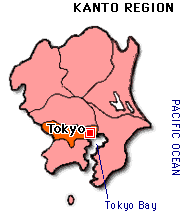The First National Meeting of
The United Nations Children's Environment Conference
|
|
|
| Geographical location | |
Tokyo (the capital of Japan) Lat. 35° 40' N Long. 139° 45' E Access from Osaka 2.5 hours by bullet train |
|
Related links Welcome to Tokyo United Nations University |
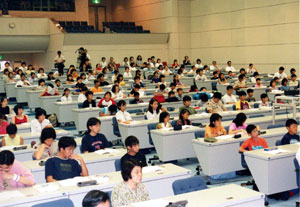 Eco
Leaders are kids who find issues in their local communities, think about how they can be solved,
and take action to improve things in the name of protecting the global environment. The first
national meeting of the United Nations Children's Environment Conference was held in order to
have kids like this come together and learn about the environment. Sponsors of the meeting included
the Ministry of the Environment and other government
ministries.
Eco
Leaders are kids who find issues in their local communities, think about how they can be solved,
and take action to improve things in the name of protecting the global environment. The first
national meeting of the United Nations Children's Environment Conference was held in order to
have kids like this come together and learn about the environment. Sponsors of the meeting included
the Ministry of the Environment and other government
ministries.
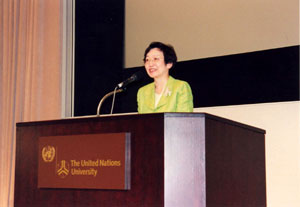 The
meeting took place on August 2 and 3, 2001. At 10:00 a.m. on the first day some 300 elementary,
middle, and high school students from around Japan who are interested in environmental activities
gathered at the United Nations University in Shibuya
Ward, Tokyo. At the opening ceremony Japan's Environment Minister Junko Kawaguchi said, "To
make the earth better and ensure that we leave nature for future generations, we must each take
action ourselves to tackle environmental problems."
The
meeting took place on August 2 and 3, 2001. At 10:00 a.m. on the first day some 300 elementary,
middle, and high school students from around Japan who are interested in environmental activities
gathered at the United Nations University in Shibuya
Ward, Tokyo. At the opening ceremony Japan's Environment Minister Junko Kawaguchi said, "To
make the earth better and ensure that we leave nature for future generations, we must each take
action ourselves to tackle environmental problems."
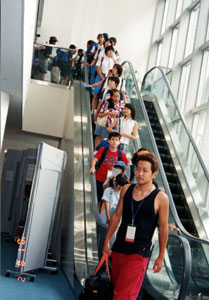 The
theme of the meeting was water, the substance most deeply linked to our daily lives. One feature
of the event was that the kids split into three groups. Each group went to parks and other facilities
around Tokyo to learn about one of three environmental themes.
The
theme of the meeting was water, the substance most deeply linked to our daily lives. One feature
of the event was that the kids split into three groups. Each group went to parks and other facilities
around Tokyo to learn about one of three environmental themes.
The first theme was "forests and land and water (rainwater, city greenery, water pipes)," and kids in this group visited Yoyogi Park and Ariake Water Station. The second theme was "living creatures and the sea/space (pollution)." This group looked at marine ecology at Kasai Rinkai Park and also went to the National Museum of Emerging Science and Innovation to listen to a talk by former astronaut Mamoru Mori, who is now director of the museum. The third theme was "plants and people (climate, plants, and underground water)." The kids in this group explored the Nature Education Park and Inogashira Park, learning many things along the way.
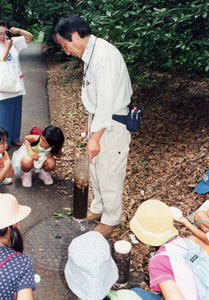 Seventh
grader Hiroko Ishida, who went to Yoyogi Park and the Meiji
Shrine to study the first theme, told us what she thought: "I was interested in the recycle
chips [made from chopped up sticks and tree branches]. Making chips from dead trees or fallen
leaves means there's no need to cut down trees that are still young and healthy. Using these chips
as recycle compost means nothing is wasted. When collecting fallen leaves to make recycle chips,
litter is a real nuisance. It takes a long time to sort out the leaves from the litter. This made
me realize how dropping litter causes trouble for other people and for nature."
Seventh
grader Hiroko Ishida, who went to Yoyogi Park and the Meiji
Shrine to study the first theme, told us what she thought: "I was interested in the recycle
chips [made from chopped up sticks and tree branches]. Making chips from dead trees or fallen
leaves means there's no need to cut down trees that are still young and healthy. Using these chips
as recycle compost means nothing is wasted. When collecting fallen leaves to make recycle chips,
litter is a real nuisance. It takes a long time to sort out the leaves from the litter. This made
me realize how dropping litter causes trouble for other people and for nature."
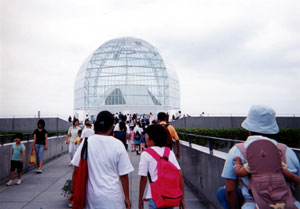 Ayaka
Ushiki, a fifth grader who went to Kasai Rinkai Park for the second theme, was very surprised
at how dirty Tokyo Bay is: "The sea water was so filthy. It was a kind of brownish color,
with garbage floating on it. Yet fish live in that water. If the fish could talk, I think they
would cry 'We can't live in such a dirty place! Help us!' If humans made the sea dirty and difficult
for fish to live there, then I think humans should make it clean again. To do this, we all decided
to work together to not drop litter and not pour away too much cooking oil at home."
Ayaka
Ushiki, a fifth grader who went to Kasai Rinkai Park for the second theme, was very surprised
at how dirty Tokyo Bay is: "The sea water was so filthy. It was a kind of brownish color,
with garbage floating on it. Yet fish live in that water. If the fish could talk, I think they
would cry 'We can't live in such a dirty place! Help us!' If humans made the sea dirty and difficult
for fish to live there, then I think humans should make it clean again. To do this, we all decided
to work together to not drop litter and not pour away too much cooking oil at home."
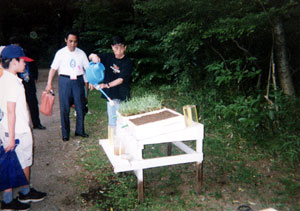 Third
grader Mayu Nukaga, who went to the Nature Education Park for the third theme, was shocked by
the results of an experiment on acid rain: "We took one dish of rainwater and one of tap
water and put a metal nail in each dish for 20 minutes. The nail in the tap water did not change
at all, but the one in the rain water turned a rusty red color. I was very surprised. I felt that
rain water is not safe. The rain water was actually acid rain. Some of the major causes of acid
rain are car exhaust fumes and smoke from factories. Of course, we need to make things in factories
and move people and things around in cars. But it's sad that nature is getting dirty all around
us as we make our lives more convenient."
Third
grader Mayu Nukaga, who went to the Nature Education Park for the third theme, was shocked by
the results of an experiment on acid rain: "We took one dish of rainwater and one of tap
water and put a metal nail in each dish for 20 minutes. The nail in the tap water did not change
at all, but the one in the rain water turned a rusty red color. I was very surprised. I felt that
rain water is not safe. The rain water was actually acid rain. Some of the major causes of acid
rain are car exhaust fumes and smoke from factories. Of course, we need to make things in factories
and move people and things around in cars. But it's sad that nature is getting dirty all around
us as we make our lives more convenient."
After the excursions, which lasted about five hours, the participants stayed overnight at the National Olympics Memorial Youth Center and brought together all the things they had learned on the three themes.
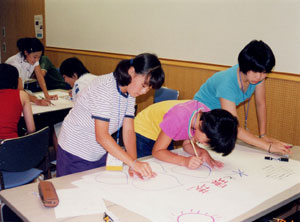 Then
came the second day. In the morning kids from schools all over Japan presented the results of
environmental efforts being made in their schools, and in the afternoon there were presentations
on the previous day's experiments and discoveries. Finally, the participants adopted the Children's
Declaration on Protecting the Global Environment, which says, "Using what we have learned
here, each of us will try our best to protect the earth so that nature and humans can live together."
This marked the end of the two-day event.
Then
came the second day. In the morning kids from schools all over Japan presented the results of
environmental efforts being made in their schools, and in the afternoon there were presentations
on the previous day's experiments and discoveries. Finally, the participants adopted the Children's
Declaration on Protecting the Global Environment, which says, "Using what we have learned
here, each of us will try our best to protect the earth so that nature and humans can live together."
This marked the end of the two-day event.
After the seminars, I felt that it is up to us to protect the beautiful earth our ancestors have worked hard to leave us," said ninth grader Ayaka Ueda.
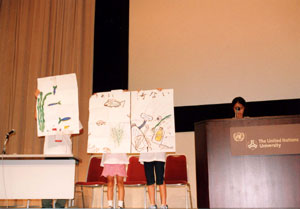 Countries
around the world are starting to tackle global environmental problems, such as the carbon dioxide
issue, but protecting the earth will require every one of us to make efforts every day. The seminar
made me feel this very strongly," said ninth-grader Chihiro Watanabe.
Countries
around the world are starting to tackle global environmental problems, such as the carbon dioxide
issue, but protecting the earth will require every one of us to make efforts every day. The seminar
made me feel this very strongly," said ninth-grader Chihiro Watanabe.
Through this seminar the kids became determined to think of the environment from a broad, global perspective. They also took the first step to becoming eco-leaders for their local regions.
Photos: (From top) Kids listen to the opening ceremony; Minister of the Environment Junko Yamaguchi addresses participants; kids leave for the three field trips; the first group went to Yoyogi Park; kids in the thrid group visit Kasai RInkai Park; kids at the Nature Education Park; kids prepare theri reports; kids present their findings and oponions.
